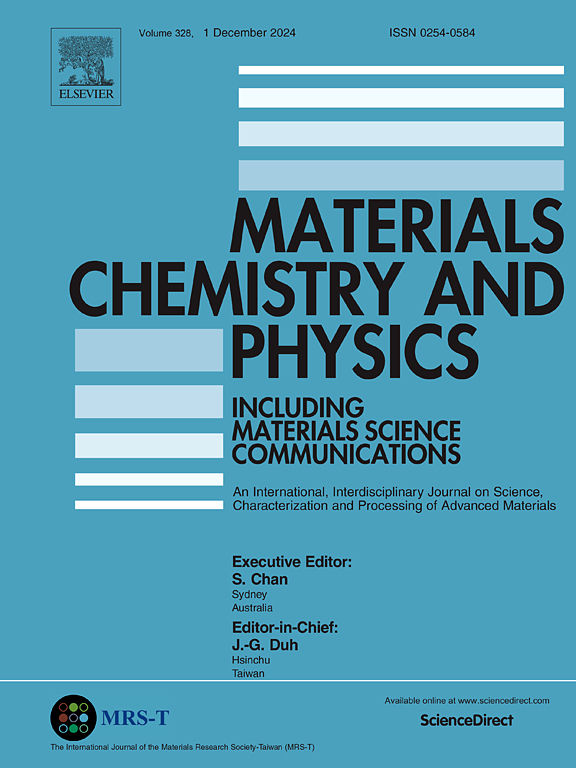K+掺杂HKUST-1金属有机骨架的环保制备,用于吸附收集CO2或挥发性有机蒸气
IF 4.7
3区 材料科学
Q2 MATERIALS SCIENCE, MULTIDISCIPLINARY
引用次数: 0
摘要
本研究旨在建立一锅、生态友好的超声波合成K-HKUST-1的方法,并将其性能与各种非常规方法进行比较。超声合成的K-HKUST-1在30 min内表现出最高的CO2吸附量(6.19 mmol/g)和CO2/N2选择性(24.92),其比表面积和孔体积均高于常规方法合成的K-HKUST-1。K-HKUST-1在潮湿环境中暴露20天后仍保持5.17 mmol/g的CO2吸附能力,显著高于亲本HKUST-1 (1.27 mmol/g)。SEM-EDS分析和密度泛函理论(DFT)计算表明,K+成功掺杂到HKUST-1框架中增加了二氧化碳吸附能力,这归因于K+掺杂产生了额外的吸附位点。值得注意的是,这项研究首次证明了使用环保方法直接将碱金属掺杂到MOF框架中,而不是传统的溶剂热方法或合成后修饰,这是该领域的重大进步。此外,对最佳K-HKUST-1样品的丙酮、苯、甲苯和对二甲苯的吸附能力进行了评估,与母体HKUST-1相比,丙酮的吸附能力提高了21%,苯的吸附能力提高了38%,甲苯的吸附能力提高了45%,对二甲苯的吸附能力提高了27%,使其成为碳捕获和VOCs去除应用的有希望的候选者。本文章由计算机程序翻译,如有差异,请以英文原文为准。

Eco-friendly preparation of K+-doped HKUST-1 metal organic framework for adsorptive collection of CO2 or volatile organic vapors
This study aims to develop a one-pot, eco-friendly synthesis of K-HKUST-1 via ultrasonication and compare its performance with various non-conventional methods. K-HKUST-1 synthesized by ultrasonication in 30 min exhibited the highest CO2 adsorption capacity (6.19 mmol/g) and CO2/N2 selectivity (24.92), consistent with its highest surface area and pore volume compared to the K-HKUST-1 synthesized by conventional methods. K-HKUST-1 retained its CO2 adsorption capacity (5.17 mmol/g) after exposure to a humid environment for 20 days, which is significantly higher than the parent HKUST-1 (1.27 mmol/g). The SEM-EDS analysis and density functional theory (DFT) calculations revealed that successful K+ doping into the HKUST-1 framework increases CO2 adsorption capacity, attributed to additional adsorption sites created by K+ doping. Notably, this study is the first to demonstrate alkali metal doping directly into the MOF framework using an eco-friendly approach, instead of traditional solvothermal methods or post-synthetic modifications, representing a major advancement in the field. Furthermore, the optimum K-HKUST-1 sample was evaluated for acetone, benzene, toluene, and p-xylene adsorption, showing capacity increases of 21 % for acetone, 38 % for benzene, 45 % for toluene, and 27 % for p-xylene compared to the parent HKUST-1 making it a promising candidate for carbon capture and VOCs removal applications.
求助全文
通过发布文献求助,成功后即可免费获取论文全文。
去求助
来源期刊

Materials Chemistry and Physics
工程技术-材料科学:综合
CiteScore
8.70
自引率
4.30%
发文量
1515
审稿时长
69 days
期刊介绍:
Materials Chemistry and Physics is devoted to short communications, full-length research papers and feature articles on interrelationships among structure, properties, processing and performance of materials. The Editors welcome manuscripts on thin films, surface and interface science, materials degradation and reliability, metallurgy, semiconductors and optoelectronic materials, fine ceramics, magnetics, superconductors, specialty polymers, nano-materials and composite materials.
 求助内容:
求助内容: 应助结果提醒方式:
应助结果提醒方式:


